|
I recently co-facilitated a professional development session with teachers around family and community engagement. During our time together, I shared three ways teachers can use technology to communicate with families. The teachers were excited to learn how they could use Canva, Google Docs, and Google Translate (many teachers are already using one or all of these) to engage with families who speak languages other than English. To streamline the presentation, I used Canva to create the following gifs, which made it so I didn't have to repeatedly show each step! The teachers found these resources and guides helpful, so I figured I'd share them out. 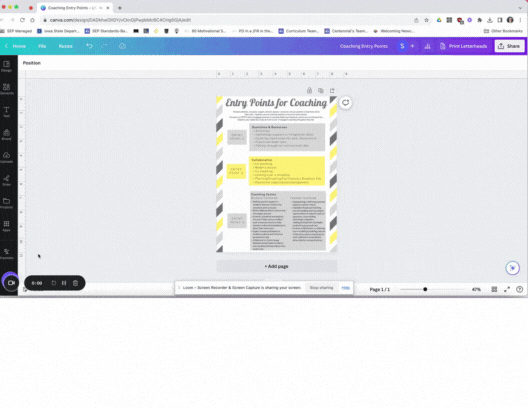 Using Canva to translate a document Using Canva to translate a document I love that Canva leaves the font style and graphics in the same location after it translates the document! If you haven't tried these out, I highly recommend you do!
0 Comments
This summer I had the opportunity to teach a four-week literacy methods course to undergraduate students. Having taken the course myself sixteen years ago, it was a full circle moment! Although the syllabus and content had been planned and passed down to me, I knew I wanted students to have the opportunity to discuss our readings collaboratively, rather than simply hearing me reiterate what they read the night before. In what follows, I share the variety of discussion strategies we used. 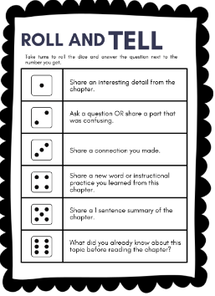 Roll & Tell Materials: Text, Dice, and Roll & Tell sheet Take turns rolling the dice and answering the question. Create a Tweet w/gif to represent the chapter 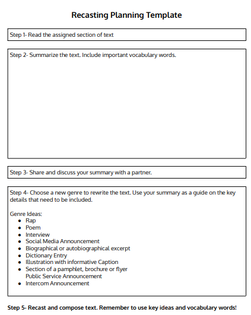 Recasting the Text - “Recasting means taking something that is currently written in one form and translating it into another form by lifting excerpts of the original and rearranging these excerpts into a new “mold”. -Angela Peery Top 5 List Make an Anchor Chart Create a Mind Map Writing Questions (and turning them into a quiz game show) Affinity Mapping
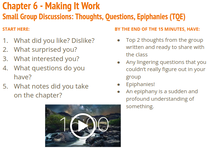 Thoughts, Questions, Epiphanies (TQE) Using these strategies allowed my students to collaborate with classmates and discuss the readings in a small group, before we discussed as a whole class.
Writing can be a profoundly reflective, cathartic, and inspiring thing. It allows me to share ideas, process thoughts, and push myself. Writing is also demanding, it takes time and ideas can be fleeting. My absence from posting ideas here has been out of choice and necessity as I spend time writing my dissertation and taking advantage of the small breaks to spend time unplugged. I will continue to post as ideas come and I have resources to share, but the frequency will vary as I continue to work on balance.
My final assignment for EL PS 630: Education Policy and Analysis, was to complete a literature review synthesis on a particular issue in educational policy that is of interest or relevance to my work. I chose to continue my focus and learning on Equity, and for the policy portion of this class, I looked at the Iowa Teaching Standards. As the graphic above shows, the standards and criteria do not explicitly include teaching with equity in mind, however there are areas where I believe these practices would fit. Recently, the administration/leadership standards were updated to include equity, so perhaps now that the principals will be writing goals around standards that include equity, the teacher standards will be updated in the near future? In the meantime, just because equity isn't included in a criterion bullet, that doesn't mean a teacher shouldn't be using these practices within their classroom.
Like educators around the country, the teachers I support as an Instructional Coach also had to move to online delivery of instruction. In order to support them in this transition, I put together an overview resource, "Flipping Your Classroom for Virtual Learning." This was meant to serve as a launching point by providing basic information.
I shared this with our teachers as a PDF and a Google Slides presentation. If you would like a copy to edit and use to support the teachers and staff you work with, I'm happy to share! We're all in this together, and I want to help educators as much as I possibly can. In addition to recording lessons on Loom and sharing weekly plans with students, teachers and staff in my building have created weekly learning hunts with optional activities for our students to enjoy. While academic tasks are included, we also feature social-emotional, physical, and kindness activities. I will continue adding the learning hunts we make to this post. If you'd like a copy of the template to use, please let me know!
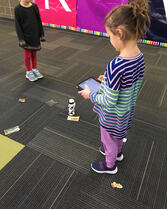 Today, I co-taught a social studies activity with our first grade team. This lesson focused on prioritizing needs vs wants. The class had discussed these two areas, and the teachers were looking for a unique way for students to work in groups to identify wants vs needs. Rather than doing a traditional sort, where students would categorize photos of items into wants and needs, the teachers reached out to me to integrate robots into the activity. In addition to serving as my Instructional Coaching office, where I meet with teachers and teams to reflect on lessons and engage in coaching conversations, my office also houses our building's Makerspace Carts, which include several types of robots. After meeting with the first grade team to learn more about the activity, I selected four types of robots: Ollie, MiP, Dash, and Grip Robot. The teachers would place photos of various wants and needs (candy bar, glass of water, video game, etc.) on the floor, and students would then navigate the robot to the needs, while avoiding the wants. Since students were in groups of 3-4, they had to work together to control the robot and successfully achieve the task. Groups spent approximately 5 minutes at each station, allowing them to use each robot. These robots will then be used in different activities as the year progresses.  Four days a week, I have the privilege and opportunity to support our first grade team during their MTSS (multi-tiered systems of support) time. I have planned a helped facilitate several enrichment activities for first grade students who have already met the end of year reading benchmarks. Earlier this year, students researched animals and created Who Would Win books. Now, they are working on story retell (CCSS RL 1.1, 1.2, 1.3) using Bloxels as we read High Time for Heroes by Mary Pope Osborn. To help facilitate the process, I created a guidebook for students to use (see photos below). As for structure/pacing/routines, we meet for 25-30 minutes, four times a week. During those times, we read a chapter and complete the planning guide section on Mondays and Thursdays. Tuesdays and Fridays are spent creating the game level for the chapter we read the previous day. The first week we did take a little extra time getting familiar with Boxels (both the kits and the app), and creating the main characters, Jack and Annie. To date, we are about halfway through the book, and the first graders are enjoying collaborating with their partner, problem solving how to create the game, and look forward to publishing their game in the near future! The photos below are from a few of their level creation days. Stay tuned to see the finished project. If you would like a copy of the guidebook, please let me know! Update March 2020:
Unfortunately, due to the extended school closures from Covid-19, this group wasn't able to meet again to finish the book or the Bloxels game. It's a disappointing way to end our time together! 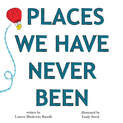 Places We Have Never Been by Lauren Ranalli Disclosure: I was gifted a copy of Places We Have Never Been to review for this event (Multicultural Children’s Book Day). Lauren Ranalli’s Places We Have Never Been invites readers to imagine what it would be like to travel to a location they have yet to experience. Throughout the pages of this book, children consider the sights, foods, language, transportation and more. Ranalli presents young readers with an opportunity to consider what it’s like in other places and to learn more about other cultures. Also, as an educator, I would be remissed if I didn’t point out connections to the Common Core State Standards. Integrating multicultural literature within all content areas is a fantastic way to bring in books that serve as windows, mirrors, and sliding glass doors (Bishop, 1990). The standards I identified were: RI.3; RI.6; RI.7, and if your state has social studies standards, I could see there being connections there as well. Even though I was gifted this book to review, whether I had come across this book on a library shelf instead, my reaction and encouragement to you to check out this book would remain the same. I am always on the lookout for diverse and multicultural literature to provide children with new perspectives, and Places We Have Never Been is an absolute must read!  As the author encouraged me to do...Enjoy the Adventure! For information about Multicultural Children’s Book Day, follow #ReadYourWorld and see the information below. Multicultural Children’s Book Day 2020 (1/31/20) is in its 7th year! This non-profit children’s literacy initiative was founded by Valarie Budayr and Mia Wenjen; two diverse book-loving moms who saw a need to shine the spotlight on all of the multicultural books and authors on the market while also working to get those book into the hands of young readers and educators. Seven years in, MCBD’s mission is to raise awareness of the ongoing need to include kids’ books that celebrate diversity in homes and school bookshelves continues. MCBD 2020 is honored to have the following Medallion Sponsors on board Super Platinum Make A Way Media/ Deirdre “DeeDee” Cummings, Platinum Language Lizard, Pack-N-Go Girls, Gold Audrey Press, Lerner Publishing Group, KidLit TV, ABDO BOOKS : A Family of Educational Publishers, PragmaticMom & Sumo Jo, Candlewick Press, Silver Author Charlotte Riggle, Capstone Publishing, Guba Publishing, Melissa Munro Boyd & B is for Breathe, Bronze Author Carole P. Roman, Snowflake Stories/Jill Barletti, Vivian Kirkfield & Making Their Voices Heard. Barnes Brothers Books, TimTimTom, Wisdom Tales Press, Lee & Low Books, Charlesbridge Publishing, Barefoot Books Talegari Tales Author Sponsor Link Cloud Jerry Craft, A.R. Bey and Adventures in Boogieland, Eugina Chu & Brandon goes to Beijing, Kenneth Braswell & Fathers Incorporated, Maritza M. Mejia & Luz del mes_Mejia, Kathleen Burkinshaw & The Last Cherry Blossom, SISSY GOES TINY by Rebecca Flansburg and B.A. Norrgard, Josh Funk and HOW TO CODE A ROLLERCOASTER, Maya/Neel Adventures with Culture Groove, Lauren Ranalli, The Little Green Monster: Cancer Magic! By Dr. Sharon Chappell, Phe Lang and Me On The Page, Afsaneh Moradian and Jamie is Jamie, Valerie Williams-Sanchez and Valorena Publishing, TUMBLE CREEK PRESS, Nancy Tupper Ling, Author Gwen Jackson, Angeliki Pedersen & The Secrets Hidden Beneath the Palm Tree, Author Kimberly Gordon Biddle, BEST #OWNVOICES CHILDREN’S BOOKS: My Favorite Diversity Books for Kids Ages 1-12 by Mia Wenjen, Susan Schaefer Bernardo & Illustrator Courtenay Fletcher (Founders of Inner Flower Child Books), Ann Morris & Do It Again!/¡Otra Vez!, Janet Balletta and Mermaids on a Mission to Save the Ocean, Evelyn Sanchez-Toledo & Bruna Bailando por el Mundo\ Dancing Around the World, Shoumi Sen & From The Toddler Diaries, Sarah Jamila Stevenson, Tonya Duncan and the Sophie Washington Book Series, Teresa Robeson & The Queen of Physics, Nadishka Aloysius and Roo The Little Red TukTuk, Girlfriends Book Club Baltimore & Stories by the Girlfriends Book Club, Finding My Way Books, Diana Huang & Intrepids, Five Enchanted Mermaids, Elizabeth Godley and Ribbon’s Traveling Castle, Anna Olswanger and Greenhorn, Danielle Wallace & My Big Brother Troy, Jocelyn Francisco and Little Yellow Jeepney, Mariana Llanos & Kutu, the Tiny Inca Princess/La Ñusta Diminuta, Sara Arnold & The Big Buna Bash, Roddie Simmons & Race 2 Rio, DuEwa Frazier & Alice’s Musical Debut, Veronica Appleton & the Journey to Appleville book series Green Kids Club, Inc. We’d like to also give a shout-out to MCBD’s impressive CoHost Team who not only hosts the book review link-up on celebration day, but who also works tirelessly to spread the word of this event. View our CoHosts HERE. Co-Hosts and Global Co-Hosts A Crafty Arab, Afsaneh Moradian, Agatha Rodi Books, All Done Monkey, Barefoot Mommy, Bethany Edward & Biracial Bookworms, Michelle Goetzl & Books My Kids Read, Crafty Moms Share, Colours of Us, Discovering the World Through My Son’s Eyes, Educators Spin on it, Shauna Hibbitts-creator of eNannylink, Growing Book by Book, Here Wee Read, Joel Leonidas & Descendant of Poseidon Reads {Philippines}, Imagination Soup, Kid World Citizen, Kristi’s Book Nook, The Logonauts, Mama Smiles, Miss Panda Chinese, Multicultural Kid Blogs, Serge Smagarinsky {Australia}, Shoumi Sen, Jennifer Brunk & Spanish Playground, Katie Meadows and Youth Lit Reviews FREE RESOURCES from Multicultural Children’s Book Day
Hashtag: Don’t forget to connect with us on social media and be sure and look for/use our official hashtag #ReadYourWorld.
This week, kindergarteners in my building were introduced to zSpace. For those who may be unfamiliar with zSpace, it is highly engaging virtual learning experience that involves students interacting with a computer program while wearing tracked glasses and using a stylus. Our district received a grant that allowed for the devices to be purchased, and the devices are shared across all eleven buildings. For our lesson, students began by exploring the demo program, which allowed them to become familiar with maneuvering the stylus and the structure of the system. We have ten devices, so students were partnered up, with one student being the “driver” and the other the “passenger.” After becoming familiar with zSpace, students entered other programs, including letter recognition and identification. There are several premade programs available for educators to search, however I found the options available for elementary students to be limited. There is an option to create your own content, so I plan to explore that further to see how I can connect this virtual learning to the Common Core State Standards. I look forward to getting first through fourth grades on zSpace as the year continues, however I want to make sure it is connected to concepts they are learning within their daily instruction. |
Archives
October 2023
Categories
All
|
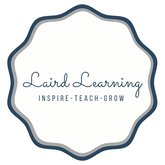
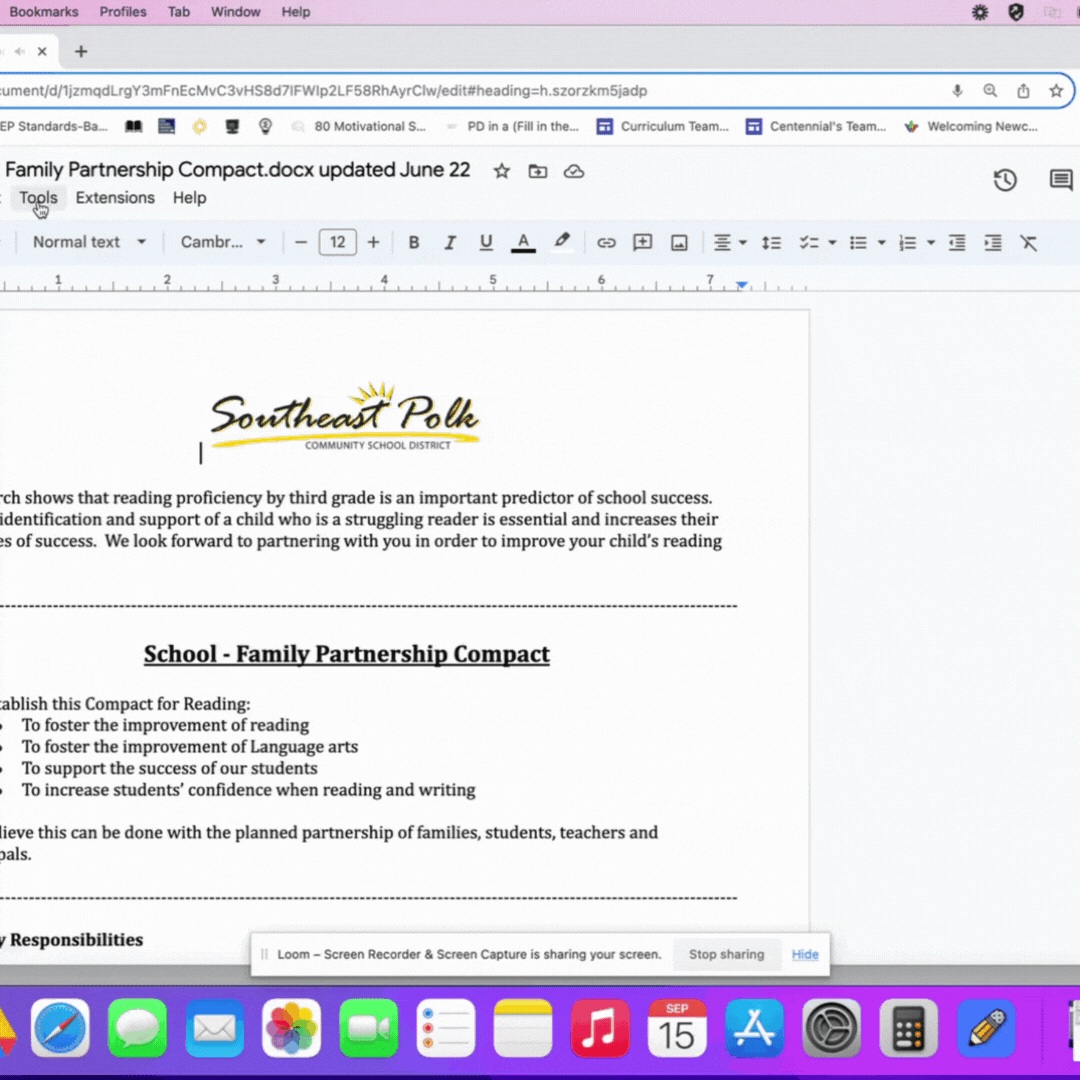
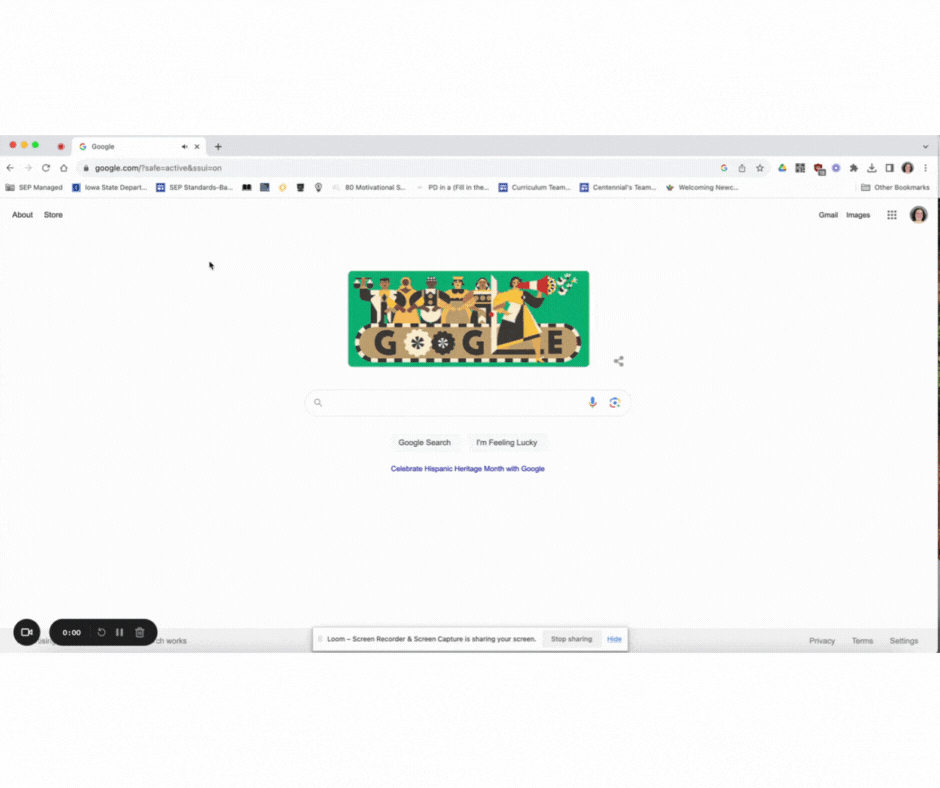
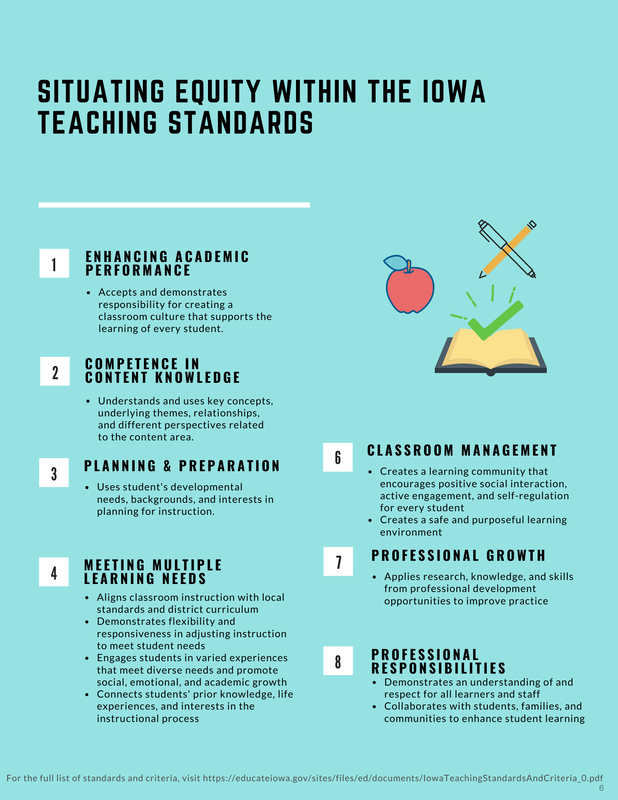
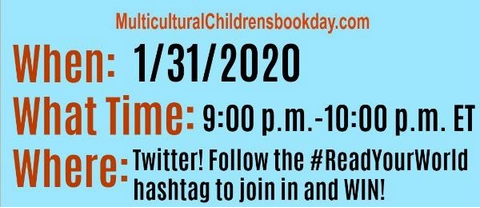
 RSS Feed
RSS Feed
